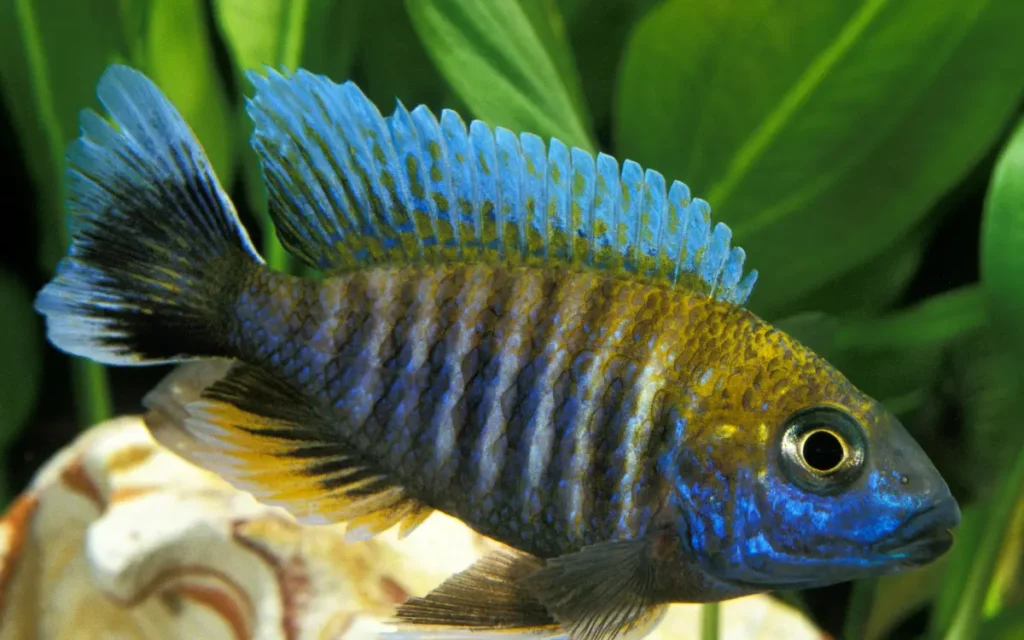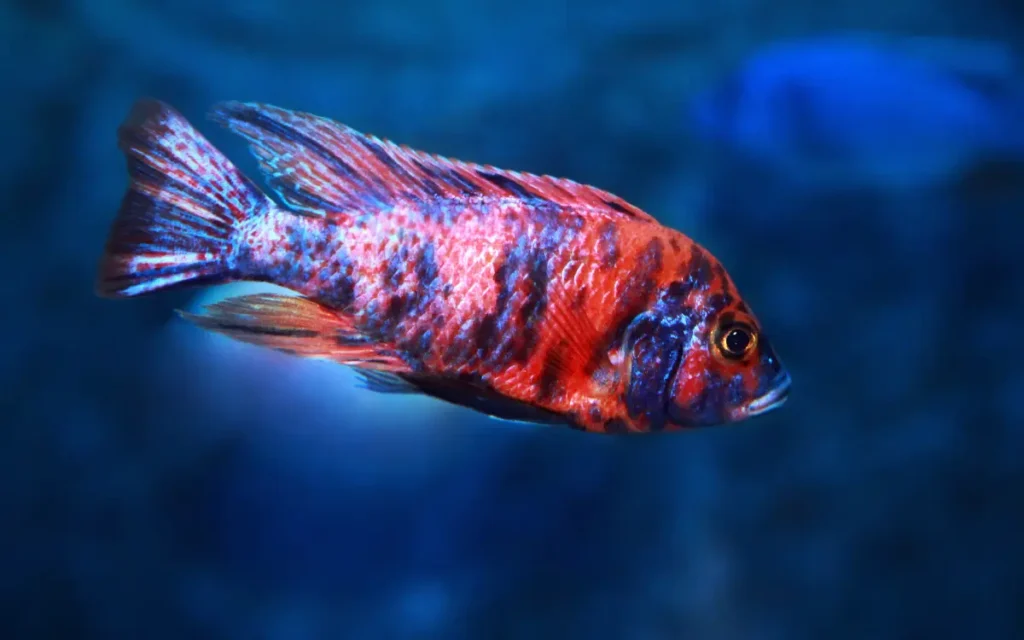The Peacock Cichlid, known for its stunning array of vibrant colors and patterns, is a popular freshwater fish among aquarists.
Native to Lake Malawi in Africa, these cichlids are prized for their striking beauty and relatively peaceful nature, making them a captivating addition to any aquarium.
Peacock Cichlid Information
| Attribute | Details |
| Family | Cichlidae |
| Aggressiveness | Moderately aggressive, especially males during breeding |
| Minimum Tank Size | 55 gallons (208 liters) |
| Life Span | 6-10 years |
| Diet | Omnivore (flakes, pellets, live or frozen foods such as brine shrimp and bloodworms) |
| Size | 4-6 inches (10-15 cm) |
| Compatibility | Compatible with other cichlids of similar size and temperament, such as Haps and Mbunas |
| Temperament | Active, territorial, but generally less aggressive than other cichlids, especially if provided with adequate space |
Tank Setup for Peacock Cichlid

Tank Size:
A minimum of 55 gallons (208 liters) is recommended to provide ample space for Peacock Cichlids, reducing territorial aggression and promoting healthy growth.
Substrate:
Use fine sand or smooth gravel as the substrate. Peacock Cichlids enjoy digging and sifting through the substrate.
Decor:
Include plenty of rocks, caves, and hiding spots to create territories and reduce aggression.
Use driftwood and other decorations to mimic their natural habitat and provide additional hiding places.
Plants:
Live plants can be included, but choose hardy species that can withstand digging and cichlid activity, such as Java Fern and Anubias.
Artificial plants can also be used if live plants are not feasible.
Water Conditions:
- Temperature: Maintain the water temperature between 78-82°F (25-28°C).
- pH: Keep the pH level between 7.8 and 8.6.
- Hardness: The ideal water hardness should be between 10-20 dGH.
Lighting:
- Moderate lighting is sufficient. Ensure a natural day-night cycle to mimic their natural environment.
Filtration:
- Use a robust filtration system to maintain excellent water quality. Peacock Cichlids produce a significant amount of waste, so an efficient filter is crucial.
- Consider using a canister filter or a high-capacity hang-on-back filter.
Aeration:
- Ensure adequate aeration to maintain proper oxygen levels. An air pump or placing the filter output to agitate the water surface can help achieve this.
Water Changes:
- Perform regular water changes of 20-30% weekly to maintain optimal water quality and prevent the buildup of harmful substances.
Feeding Peacock Cichlid

Diet Overview:
Peacock Cichlids are omnivores and require a balanced diet consisting of both plant and animal matter to thrive and display vibrant colors.
Staple Foods:
High-Quality Flake Food:
- Choose flake food specifically formulated for cichlids to provide essential nutrients.
- Ensure the flakes are suitable for omnivorous species.
Pellets:
- Use cichlid pellets or micro pellets as a staple part of their diet.
- Pellets should be designed for omnivorous cichlids to ensure a balanced diet.
Supplementary Foods:
Live Foods:
- Brine shrimp, bloodworms, and daphnia are excellent sources of protein and can be given occasionally.
- Live foods help stimulate natural hunting behaviors and provide high-quality protein.
Frozen Foods:
- Frozen brine shrimp, bloodworms, and mysis shrimp are convenient alternatives to live foods.
- Ensure they are properly thawed before feeding.
Vegetables:
- Blanched spinach, peas, and zucchini can be offered occasionally to provide necessary plant-based nutrients and fiber.
- Ensure vegetables are finely chopped or mashed to make them easier to consume.
Feeding Schedule:
- Feed Peacock Cichlids small amounts 2-3 times daily.
- It is better to feed them smaller portions multiple times a day to prevent overfeeding and ensure all fish get a chance to eat.
Portion Size:
- Only provide as much food as they can consume in 2-3 minutes.
- Overfeeding can lead to water quality issues and health problems for the fish.
Feeding Tips:
- Vary their diet to prevent nutritional deficiencies and keep them interested in their food.
- Remove uneaten food after feeding to maintain water quality.
- Use a combination of floating and sinking foods to cater to their different feeding habits.
- Occasionally add specialized foods like spirulina flakes or high-protein fry food to diversify their diet and support their health, especially during breeding periods.
Breeding Peacock Cichlid
Tank Setup for Breeding:
Separate Breeding Tank: Use a separate breeding tank with a minimum size of 55 gallons (208 liters). This tank should be well-planted with plenty of hiding spots and territories.
Substrate: Use fine sand or smooth gravel to create a comfortable environment for egg laying.
Decor: Provide flat rocks or broad leaves for the cichlids to lay their eggs on. Include caves, driftwood, and other decorations to create hiding spots and territories.
Water Conditions:
Temperature: Maintain the water temperature between 78-82°F (25-28°C).
pH Level: Keep the pH level between 7.8 and 8.6.
Hardness: The ideal water hardness should be between 10-20 dGH.
Conditioning the Fish:
Select Healthy Breeders: Choose a healthy male and several females. Males are typically more colorful and larger. Condition the breeders by feeding them a varied diet of high-quality flakes, live foods (like brine shrimp and daphnia), and frozen foods.
Feeding: Increase the frequency and quality of feedings to prepare the fish for breeding. Offer a variety of live and frozen foods to enhance their health and readiness.
Breeding Behavior:
Courtship Displays:
- Males will display vibrant colors and engage in elaborate courtship dances to attract females.
Spawning Process:
- The female will lay eggs on a flat surface, which the male will then fertilize.
- Spawning can last several hours, with the pair becoming more territorial during this time.
Egg and Fry Care:
- Egg Care:
- The parents will guard the eggs, which will hatch in about 2-3 days.
- Both parents will fan the eggs to keep them clean and oxygenated.
- Fry Care:
- Once the fry hatch, they will become free-swimming approximately 5-7 days later.
- The parents will continue to guard the fry, leading them around the tank to find food.
Feeding Fry:
Initial Food:
- Start feeding the fry infusoria or commercially available liquid fry food once they become free-swimming.
- As the fry grow, transition them to finely crushed flake food or powdered fry food.
Growth:
- Gradually introduce larger foods such as micro pellets as the fry grow.
Raising Fry:
Water Quality:
- Maintain excellent water quality by performing regular water changes.
- Use an air-driven sponge filter to provide gentle filtration without harming the fry.
Monitoring Growth:
- Keep an eye on the fry’s growth and health. Separate any significantly larger individuals to prevent bullying and ensure even growth.
Transition to Main Tank:
- Once the fry are large enough not to be eaten (usually around 1 inch or 2.5 cm), they can be gradually acclimated and introduced to the main tank.
Peacock Cichlid Tank Mates
Ideal Tank Mates:
Haplochromis (Haps):
- Peaceful to moderately aggressive cichlids from Lake Malawi that can coexist well with Peacock Cichlids.
Mbuna Cichlids:
- Small to medium-sized, colorful cichlids from Lake Malawi. Choose less aggressive species to minimize conflicts.
Synodontis Catfish:
- Bottom-dwelling catfish that are peaceful and help keep the tank clean.
Plecos (Small species):
- Such as Bristlenose Plecos, which are good for algae control and are peaceful tank mates.
Yellow Labs (Labidochromis caeruleus):
- Brightly colored and relatively peaceful cichlids that can add a striking contrast to the tank.
Electric Blue Ahli (Sciaenochromis fryeri):
- A beautiful and relatively peaceful cichlid that can coexist with Peacocks.
Aulonocara Species:
- Other species of Peacock Cichlids can be kept together, provided there is enough space and hiding spots to reduce territorial disputes.
- Active and peaceful fish that add color and movement to the tank without causing aggression.
Tiger Barbs (in large groups):
- Known for their active behavior, they can coexist if kept in large groups to minimize fin-nipping.
Clown Loaches:
- Peaceful bottom dwellers that add variety and help control snails.
FAQs
Are peacock fish poisonous?
No, Peacock Cichlids are not poisonous. They are safe to keep in aquariums and pose no toxic threat to humans or other fish.
Do peacock cichlids lay eggs?
Yes, Peacock Cichlids lay eggs. They are oviparous and will lay eggs on flat surfaces, such as rocks or leaves, which are then fertilized by the male.
Can two different cichlids mate?
Yes, different species of cichlids can sometimes mate, resulting in hybrid offspring. However, this is not always advisable as it can lead to unpredictable behavior and appearance in the fry.
Do cichlids eat other fish?
Yes, cichlids can eat other fish, especially if the tank mates are significantly smaller or if the cichlids are particularly aggressive. It’s important to choose compatible tank mates to minimize predation.
Do cichlids recognize you?
Yes, cichlids can recognize their owners. They are intelligent fish and often learn to recognize their caregivers, responding to their presence, especially at feeding times.

